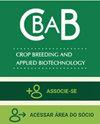大豆花期细菌性脓疱抗性的原因变异位点和蛋白质编码基因
IF 1.1
4区 农林科学
Q2 Agricultural and Biological Sciences
引用次数: 1
摘要
细菌性脓疱是柑橘黄单胞菌引起的一种重要的大豆病害。甘氨酸,但关于这种病原体的遗传抗性的信息很少。本研究旨在通过关联分析、候选SNP标记的鉴定和鉴定可能调节防御过程的蛋白质编码基因,研究大豆在开花阶段对细菌性脓疱的遗传抗性。因此,用6k Illumina平台对109个大豆品种进行了疾病严重程度的评估。全基因组分析显示,共有13个snp显著相关。通过蛋白质注释,我们确定了位于未鉴定蛋白LOC100779077、组蛋白赖氨酸Nmethyltransferase SUVR4和ABC-transporter B family member-9编码区内的三个标记。前两个标记上的核苷酸多态性产生了从疏水氨基酸到极性氨基酸的非同义多态性。为了便于在标记辅助大豆育种计划中使用这三个候选标记,对验证程序进行优先排序是方便的。本文章由计算机程序翻译,如有差异,请以英文原文为准。
Causal variant loci and protein-coding genes for soybean bacterial pustule resistance in the flowering stage
Bacterial pustule is an important soybean disease caused by Xanthomonas citri pv. glycines, but information about genetic resistance to this pathogen is scarce. This study aimed to investigate soybean genetic resistance to bacterial pustule in the flowering stage through association analysis, characterization of candidate SNP markers, and identification of protein-coding genes potentially regulating defense processes. Therefore, 109 soybean cultivars genotyped with a 6k Illumina platform were assessed for disease severity. A genome-wide analysis revealed a total of 13 SNPs significantly associated. Through protein annotation, we identified three markers located inside the coding regions of uncharacterized protein LOC100779077, histone-lysine Nmethyltransferase SUVR4, and ABC-transporter B family member-9. Nucleotide polymorphism on the first two of these markers produces a non-synonymous polymorphism with polarity shift from hydrophobic to polar amino acid. It is convenient to prioritize these three candidate markers for validation procedures with the purpose of using them in marker-assisted soybean breeding programs.
求助全文
通过发布文献求助,成功后即可免费获取论文全文。
去求助
来源期刊
CiteScore
2.40
自引率
13.30%
发文量
25
审稿时长
6-12 weeks
期刊介绍:
The CBAB – CROP BREEDING AND APPLIED BIOTECHNOLOGY (ISSN 1984-7033) – is the official quarterly journal of the Brazilian Society of Plant Breeding, abbreviated CROP BREED APPL BIOTECHNOL.
It publishes original scientific articles, which contribute to the scientific and technological development of plant breeding and agriculture. Articles should be to do with basic and applied research on improvement of perennial and annual plants, within the fields of genetics, conservation of germplasm, biotechnology, genomics, cytogenetics, experimental statistics, seeds, food quality, biotic and abiotic stress, and correlated areas. The article must be unpublished. Simultaneous submitting to another periodical is ruled out. Authors are held solely responsible for the opinions and ideas expressed, which do not necessarily reflect the view of the Editorial board. However, the Editorial board reserves the right to suggest or ask for any modifications required. The journal adopts the Ithenticate software for identification of plagiarism. Complete or partial reproduction of articles is permitted, provided the source is cited. All content of the journal, except where identified, is licensed under a Creative Commons attribution-type BY. All articles are published free of charge. This is an open access journal.

 求助内容:
求助内容: 应助结果提醒方式:
应助结果提醒方式:


